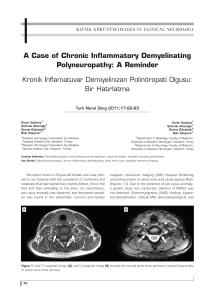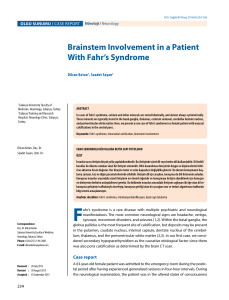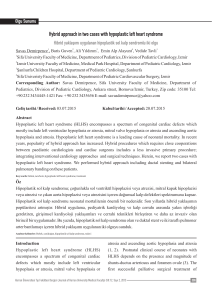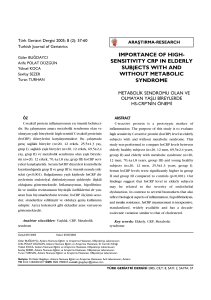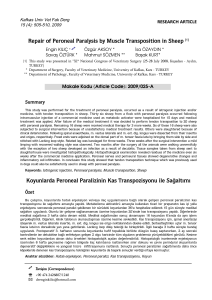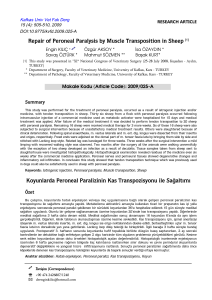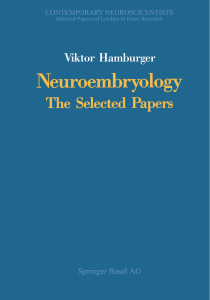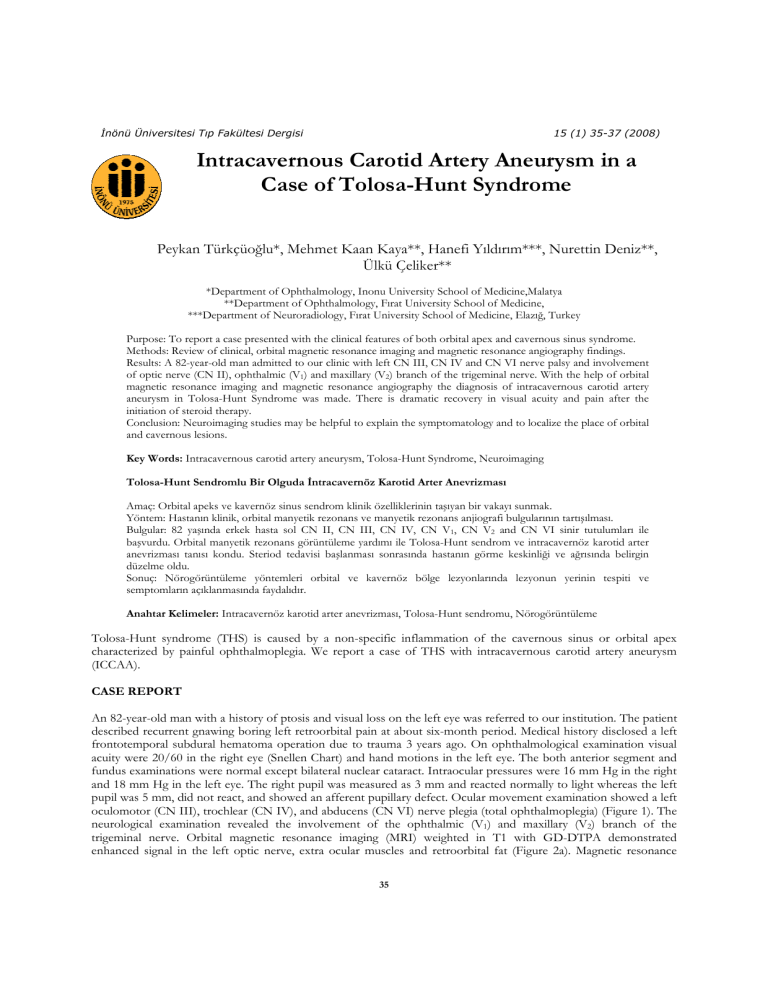
İnönü Üniversitesi Tıp Fakültesi Dergisi
15 (1) 35-37 (2008)
Intracavernous Carotid Artery Aneurysm in a
Case of Tolosa-Hunt Syndrome
Peykan Türkçüoğlu*, Mehmet Kaan Kaya**, Hanefi Yıldırım***, Nurettin Deniz**,
Ülkü Çeliker**
*Department of Ophthalmology, Inonu University School of Medicine,Malatya
**Department of Ophthalmology, Fırat University School of Medicine,
***Department of Neuroradiology, Fırat University School of Medicine, Elazığ, Turkey
Purpose: To report a case presented with the clinical features of both orbital apex and cavernous sinus syndrome.
Methods: Review of clinical, orbital magnetic resonance imaging and magnetic resonance angiography findings.
Results: A 82-year-old man admitted to our clinic with left CN III, CN IV and CN VI nerve palsy and involvement
of optic nerve (CN II), ophthalmic (V1) and maxillary (V2) branch of the trigeminal nerve. With the help of orbital
magnetic resonance imaging and magnetic resonance angiography the diagnosis of intracavernous carotid artery
aneurysm in Tolosa-Hunt Syndrome was made. There is dramatic recovery in visual acuity and pain after the
initiation of steroid therapy.
Conclusion: Neuroimaging studies may be helpful to explain the symptomatology and to localize the place of orbital
and cavernous lesions.
Key Words: Intracavernous carotid artery aneurysm, Tolosa-Hunt Syndrome, Neuroimaging
Tolosa-Hunt Sendromlu Bir Olguda İntracavernöz Karotid Arter Anevrizması
Amaç: Orbital apeks ve kavernöz sinus sendrom klinik özelliklerinin taşıyan bir vakayı sunmak.
Yöntem: Hastanın klinik, orbital manyetik rezonans ve manyetik rezonans anjiografi bulgularının tartışılması.
Bulgular: 82 yaşında erkek hasta sol CN II, CN III, CN IV, CN V1, CN V2 and CN VI sinir tutulumları ile
başvurdu. Orbital manyetik rezonans görüntüleme yardımı ile Tolosa-Hunt sendrom ve intracavernöz karotid arter
anevrizması tanısı kondu. Steriod tedavisi başlanması sonrasında hastanın görme keskinliği ve ağrısında belirgin
düzelme oldu.
Sonuç: Nörogörüntüleme yöntemleri orbital ve kavernöz bölge lezyonlarında lezyonun yerinin tespiti ve
semptomların açıklanmasında faydalıdır.
Anahtar Kelimeler: Intracavernöz karotid arter anevrizması, Tolosa-Hunt sendromu, Nörogörüntüleme
Tolosa-Hunt syndrome (THS) is caused by a non-specific inflammation of the cavernous sinus or orbital apex
characterized by painful ophthalmoplegia. We report a case of THS with intracavernous carotid artery aneurysm
(ICCAA).
CASE REPORT
An 82-year-old man with a history of ptosis and visual loss on the left eye was referred to our institution. The patient
described recurrent gnawing boring left retroorbital pain at about six-month period. Medical history disclosed a left
frontotemporal subdural hematoma operation due to trauma 3 years ago. On ophthalmological examination visual
acuity were 20/60 in the right eye (Snellen Chart) and hand motions in the left eye. The both anterior segment and
fundus examinations were normal except bilateral nuclear cataract. Intraocular pressures were 16 mm Hg in the right
and 18 mm Hg in the left eye. The right pupil was measured as 3 mm and reacted normally to light whereas the left
pupil was 5 mm, did not react, and showed an afferent pupillary defect. Ocular movement examination showed a left
oculomotor (CN III), trochlear (CN IV), and abducens (CN VI) nerve plegia (total ophthalmoplegia) (Figure 1). The
neurological examination revealed the involvement of the ophthalmic (V1) and maxillary (V2) branch of the
trigeminal nerve. Orbital magnetic resonance imaging (MRI) weighted in T1 with GD-DTPA demonstrated
enhanced signal in the left optic nerve, extra ocular muscles and retroorbital fat (Figure 2a). Magnetic resonance
35
Türkçüoğlu et al
Figure 2b: Magnetic resonance angiography shows
an aneurysm of the C3 and C4 intracavernous part of
left internal carotid artery (ICA) measured 20X19X18
mm.
angiography (MRA) revealed an aneurysm of the C3
and C4 intracavernous part of left internal carotid
artery (ICA) measured 20X19X18 mm (Figure 2b).
The patient refused angiography, endovascular
treatment and biopsy. After the initiation of steroid
therapy (oral fluocortolone, 60 mg/day), there was a
dramatic reduction of pain within 24 hours. At the
third day of the steroid therapy visual acuity was
20/120 on the left eye. The steroid dose was
decreased to 40 mg/day after the second week.
However ophthalmoplegia did not regressed till the
end of one-month. The patient refused to attain our
follow-up procedure.
Figure 1. Ocular movement examination showed
total ophthalmoplegia.
DISCUSSION
Tolosa-Hunt syndrome is one of the causes of orbital
apex syndrome (OAS). OAS is characterized by
variable deficits of CN III, CN IV, CN VI, and
ophthalmic branch of the trigeminal nerve (V1) in
association with optic nerve dysfunction. Cavernous
sinus syndrome (CSS) may include the features of an
OAS with added involvement of the maxillary branch
of the trigeminal nerve (V2).1
Figure 2a: GD-DTPA enhanced T1- weighted axial
magnetic resonance imaging shows enhanced signal at
left optic nerve (open arrow), extra ocular muscles
(solid arrow) and retroorbital fat (arrow head).
Our patient presented with both the clinical features
of orbital apex and CSS. After the initiation of the
steroid therapy the optic nerve dysfunction, pain and
hypoesthesia at the tributary of the ophthalmic
branch of the trigeminal nerve (V1) reversed but the
symptoms due to involvement of the other cranial
nerves persist. The involvement of the CN III, CN
IV, CN VI, maxillary branch of the trigeminal nerve
(V2) and optic nerve, ophthalmic branch of the
trigeminal nerve (V1) were due to ICCAA and orbital
apex inflammation, respectively.
Intracavernous carotid artery aneurysm due to
inflammatory infiltration was reported previously in a
Tolosa-Hunt syndrome patient.2 In our patient
inflammation did not extend up to cavernous sinus so
the probable mechanism of the aneurysm might be
previous head trauma that was reported as an
etiological factor.3
.
Before modern computed tomographic (CT) or MRI,
radiographic evaluation for THS consisted of
angiography and plain films. Angiographic features in
36
Intracavernous Carotid Artery Aneurysm in a Case of Tolosa-Hunt Syndrome
THS include narrowing of the carotid siphon,
occlusion of the superior ophthalmic vein,
nonvisualization of the cavernous sinus.4 However, a
normal orbital venogram or arterogram does not
exclude THS.5 Although CT may occasionally reveal
enhancing lesions in the cavernous sinus or orbital
apex, the appearances are nonspecific. Contrary to
other neuroradiological studies which may be normal,
MRl are very sensitive tools for the diagnosis of
THS.6
REFERENCES
The symptomatology of OAS and CSS interdigitate
to each other. All cranial nerves must be examined
carefully in order to localize the place of the lesion.
Neuroimaging studies especially MRI may be helpful
to explain the symptomatology.
Correspondence to:
1.
2.
3.
4.
5.
6.
Yeh S, Foroozan R. Orbital apex syndrome. Curr Opin Ophthalmol. 2004;15:4908.
Kambe A, Tanaka Y, Numata H, Kawakami S, Kurosaki M, Ohtake M, Kamitani
H,Miyata H, Ohama E, Watanabe T. A case of Tolosa-Hunt syndrome affecting
both the cavernous sinuses and the hypophysis, and associated with C3 and C4
aneurysms. Surg Neurol. 2006;65:304-7.
Keane JR. Cavernous sinus syndrome. Analysis of 151 cases. Arch Neurol.
1996;53:967-71.
Sondheimer FK, Knapp J. Angiographic findings in the Tolosa-Hunt syndrome:
painful ophthalmoplegia. Radiology. 1973;106:105-12.
Muhletaler CA, Gerlock AJ Jr. Orbital venography in painful ophthalmoplegia
(Tolosa-Hunt syndrome). AJR Am J Roentgenol. 1979;133:31-4.
de Arcaya AA, Cerezal L, Canga A, Polo JM, Berciano J, Pascual J. Neuroimaging
diagnosis of Tolosa-Hunt syndrome: MRI contribution. Headache. 1999;39:321-5.
Yrd.Doç.Dr.Peykan TÜRKÇÜOĞLU,
Assistant Professor of Ophthalmology
İnonu University School of Medicine
Department of Ophthalmology
Malatya Turkey
E-mail: [email protected]
Fax : 424 238 80 96
Tel : 424 233 35 55
37

